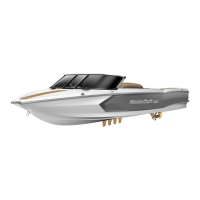2021 OWNERS MANUAL / 432
• Check for foam or bubbles in the brake fluid. If either is present,
drain the fluid from the master cylinder and replace with ONLY
new brake fluid of the same type (DOT 3 is preferred—or DOT 4).
DO NOT USE DOT 5 FLUID. (See specific information in Recom-
mended Brake Fluid in this section of this Owner’s Manual.)
• In order for brakes to function properly, all air must be expelled
from the brake system. If bleeding is necessary, have an au-
thorized MasterCraft dealer perform this function or follow the
manual bleeding of the brake system instructions as outlined in
this Owner’s Manual. It is imperative that the system be filled with
only ONE type of brake fluid. Dierent types do not mix. Follow the
instructions on the brake fluid container.
• Check the safety chains and attachment points for damage or
wear. Repair or replace as necessary.
• Check the breakaway cable for worn or frayed cable strands. End
fittings should be checked for damage. Replace as necessary.
• Check for any hydraulic leaks in the brake system. Be sure all tube
fittings are tight. Periodic checks must be made on all hoses, brake
line tubing and fittings to guard against cuts, worn hoses and loose
fittings that may cause leaks in the trailer brake hydraulic system.
Replace deteriorated and damaged parts as necessary.
• Check for chips and nicks in the paint. Touch up as necessary. Ignor-
ing this will lead to accelerated wear and deterioration of the trailer.
• Check the condition of the bunks. If the coverings show wear,
discuss with an authorized MasterCraft dealer. If the coverings are
not in good condition or if the bunk sub-frame shows any damage,
Annually Or Every 2,000 Miles, Whichever
Occurs First (In Addition To The Above)
• To assure the bearings are in good working order, check the bear-
ing adjustment at least once a year by following this procedure:
Jack up one side of the trailer. (Be certain to use jack stands and
chock the trailer wheels to keep the trailer from moving during
the inspection.) Grip the edge of the tire and see if it can be
rocked or moved. If the outer edge of the tire moves more than
1/8” at all, the bearings may need to be readjusted.
• Inspect the tow hitch for corrosion or damage. Repair or replace
components as necessary.
• Check for wear on the hitch ball. If the ball is worn, it is UNSAFE
and must be replaced.
• Check the coupler mechanism for smooth operation. If the latch
handle does not spring open after being disengaged, lubricate
the points on the coupler latch mechanism.
• Check the actuator for excessive wear. If the outer member is
rubbing against the inner, wear marks will show on top of the
coupler just forward of the outer member. Contact an authorized
MasterCraft dealer for replacement parts.
• Check the actuator travel. Excessive actuator travel (over one
inch) when the brakes are applied indicates air in the brake lines.
• Check the brake fluid in the master cylinder reservoir. On the
actuator, remove the cap to the master cylinder reservoir by un-
screwing the cap in a counter-clockwise direction. The brake fluid
level should be 1/8” below the threads.
2021MCOwnerManualFINAL.indd 432 8/26/20 1:55 PM
